Opportunity; Maintenance, repair and alteration under the ASTM consensus standard
Although Light Sport Aircraft (LSA) have been around since the 2004 FAA acceptance of the ASTM consensus standards under which they are designed, manufactured, maintained, repaired, and altered, most A&Ps trained and experienced in aircraft with standard airworthiness certificates have been reluctant to venture into this new world. With 125 models now in production around the world, most of which are fixed wing aircraft, and 2,235 fixed-wing Light Sport Aircraft already on the FAA registry as of the end of 2011, this newest aircraft industry segment offers growth potential for any maintenance shop willing to tackle the initially steep, but potentially rewarding learning curve.
Eric Paradis, of AeroParadise LLC, is proof positive of this proposition. A traditionally trained A&P/IA with previous experience running from Piper J-3s to Boeing 747s, Paradis and his wife, Karla, settled down a few years ago at the Reedsburg, WI, municipal airport to develop a general aviation maintenance shop catering to standard category airplanes as well as Experimental Amateur-built aircraft, including a custom aircraft interior shop. Paradis was well poised to take advantage of the LSA rules. According to Paradis, this new focus on LSA maintenance services now accounts for about half of their maintenance business.
Paradis has been especially aggressive in his expansion efforts, attending many manufacturers’ training courses, and securing service center designations from Remos, Tecnam, Sting Sport, and Rotax. Clearly he is one A&P/IA who has not been daunted by these new challenges, but chose instead to embrace the opportunities.
ASTM consensus standards
Following a federal policy mandate to promote the use of industry-developed consensus (voluntary) standards in government regulation and procurement, the ASTM Light Sport Committee F37 was created, comprised of industry members and overseen by the FAA, which “accepts,” rather than “approves” the individual standards as they are developed and amended.
The five most important standards concerning Light Sport fixed wing aircraft are F2626 Standard Terminology; F2245 Standard Specification for Design and Performance; F2279 Standard Practice for Quality Assurance in the Manufacture of Fixed Wing LSAs; F2295 Standard Practice for Continued Operational Safety Monitoring of LSAs; and F2483 Standard Practice for Maintenance and the Development of Maintenance Manuals for LSAs. These last two standards, F2295 and F2483, along with a few definitions out of F2626, are probably the most important provisions to maintenance professionals.
The Sport Pilot/Light Sport Aircraft Rules created two new categories of Airworthiness Certificates (Figure 1). These are Special Light Sport Aircraft (S-LSA) and Experimental Light Sport Aircraft (E-LSA), as detailed in FARs 21.190, 21.191, and 21.193. The airworthiness certificates for both of these new categories are pink, like the Experimental Amateur-built certificates you might have seen in homebuilts.
S-LSA are the fully manufactured, fly-away aircraft we are seeing with increasing frequency on airport ramps around the country, including such industry leaders as the Flight Design CTLS; Czech Sport Aircraft SportCruiser; American Legend Cub; Cubcrafters Sport Cub; Tecnam P2008; and Remos GX NXT.
E-LSA are either: (1) kitted versions of an S-LSA; (2) aircraft that have been down-graded from an original S-LSA airworthiness certificate to an E-LSA; or (3) aircraft of various descriptions that were brought into the system during a brief window following the adoption of the new rules, usually two-place ultralights. Our primary focus here is the S-LSAs.
Airworthiness certificates issued under LSA regulations come with operating limitations which must be scrupulously adhered to in maintaining these aircraft. For instance, these limitations typically include an express statement of what the logbook entries concerning the annual condition inspection must recite, and it varies from the more familiar language most often used in signing off an aircraft with a Standard Airworthiness Certificate for return to service. If the precise language is not used, the S-LSA will not be “in a condition for safe flight.”
Paperwork is different with Light Sport Aircraft, and it is not unusual for an S-LSA to show up for maintenance with incorrect records, according to Eric Paradis and other AMTs I’ve talked to. These problems often stem from an uninformed A&P failing to appreciate the system of manufacturer-controlled maintenance, and thinking he or she is operating in the Standard class system of FAA-controlled maintenance. Worse, the actual work done on the S-LSA that lies behind those erroneous maintenance records is often at odds with the manufacturer’s maintenance manual, which is the maintenance bible for these aircraft, not AC 43.13. This fundamental misunderstanding is often reflected in an AMT sending the FAA a Form 337, which has no place in the ASTM-defined maintenance system.
Not only does the S-LSA manufacturer’s maintenance manual define precisely how maintenance is to be preformed, but it also prescribes what maintenance tasks can be undertaken, and by who. F2295, the standard for continued operational safety monitoring of LSAs, varies substantially from the Airworthiness Directives system familiar to most AMTs, and needs to be understood as well.
S-LSA maintenance basics
Any maintenance, repair, inspection or alteration for which instructions are provided in the maintenance manual is defined as “minor.” Any such activities not detailed in the manual are “major.” “Heavy” maintenance requires specialized training, equipment, or facilities, as determined by the manufacturer. “Line” maintenance includes tasks not defined as heavy that are approved by the manufacturer and specified in the manual. “Overhaul” includes activities that may only be accomplished by the manufacturer, or at a facility specifically approved by the manufacturer. While these definitions, abbreviated here, are a little confusing, they appear to have some overlap, and raise additional questions of interpretation, the point is that they are defined either by an applicable ASTM standard or the manufacturer, not by any FAR, Advisory Circular, or other FAA guidance. The manufacturer controls the maintenance process.
Any maintenance, repair, or alteration not specified in the maintenance manual must be accomplished pursuant to specific instructions from the manufacturer, which will issue a Letter of Authority (LOA) to the owner and AMT. This LOA must be made part of the aircraft’s permanent maintenance records. (Do not send it to the FAA!) Some manufacturers are better than others in managing this procedure in actual practice, and many S-LSAs are technically no longer in a condition for safe flight due to failure to comply with this process.
Manufacturers’ manuals also specify who may perform maintenance and required annual condition inspections on S-LSAs. Generally, this will be either an Airframe and Power Plant mechanic (Inspection Authorization not required), a Light Sport repairman with a maintenance rating, LSR-M, or an employee of a certified repair station rated for this type of work. Holders of Sport and higher pilot certificates may also perform specified maintenance tasks. Again, it is all laid out in the manufacturer’s maintenance manual, which is itself issued pursuant to requirements of ASTM Standard F2483.
Controversial issues
Two trouble spots have lately developed between ASTM and Type Certificated aircraft worlds. First, as part of the basic concept of manufacturer-controlled maintenance, it was initially thought that airframe and engine manufacturers of ASTM-compliant products could require that AMTs take factory-approved training before they could work on their products, and many manufacturers have done so. Rotax, whose engines are in about 80 percent of S-LSAs manufactured today, is the best example of this.
Many of the manufacturers of Rotax-powerd S-LSAs, in turn, have made Rotax factory training a requirement of their aircraft maintenance manuals by requiring that the Rotax requirements be met. On Feb. 12, 2012, the Office of the Chief Counsel of the FAA issued a letter opining that manufacturers cannot legally require AMTs to obtain factory training before working on their products. This opinion surprised many in the industry since it seems to be at odds with the notion that the ASTM consensus standard system is controlled by the manufacturers. It is likely we have not seen the end of this controversy.
The second hot spot in the S-LSA world concerns the manner in which Airworthiness Directives on type certificated components incorporated into S-LSA are to be communicated to owners and maintenance personnel. Initially it was understood that such continued airworthiness information would be disseminated via the “Notice of Corrective Action” system established by ASTM Standard F2295. Again, FAA legal counsel have recently published an opinion that ADs are independently applicable to S-LSA pursuant to FAR 91.327(b)(3). Since some S-LSA manufacturers have not done a very good job of running their continued airworthiness systems under the ASTM standard, the FAA’s concern here is understandable. Any AMT working on these aircraft must pay close attention to this as yet unresolved issue, and be certain that all applicable ADs have been addressed. Do not rely upon the manufacturer to provide notice.
ASTM is here to stay
None of the apparent complexities of the new system, or the problem areas that have developed, have deterred Paradis. He enjoys working on these often very innovative aircraft, gets the factory training, and has learned the system well. His reputation has developed to the point where most S-LSA owners in the area are aware of AeroParadise. (Visit www.aeroparadise.com)
Although the industry is struggling to increase sales volume, S-LSAs and the ASTM consensus standard system are here to stay. It is inevitable that more and more maintenance shops will embrace this new segment in the next few years as the number of these aircraft needing service continues to increase. For now, the field is wide open to the early adapters. For more information regarding ASTM visit www.astm.org.
Ed Leineweber is an aviation and business attorney practicing in Madison, WI. He is a CFII and holds the LSRM certificate. A retired Wisconsin Circuit Court Judge, Ed previously operated two FBOs and managed both airports. He is an incurable Bowers Fly Baby aficionado; currently completing a Fly Baby project and restoring a nearly 50-year-old Fly Baby. Ed regularly writes a SP/LSA column for the Midwest Flyer Magazine. He can be reached at [email protected] and (608) 604-6515.
About the Author

Ed Leineweber
Ed Leineweber is an aviation and business attorney practicing in Madison, WI. He is a CFII and holds the LSRM certificate. A retired Wisconsin Circuit Court Judge, Ed previously operated two FBOs and managed both airports. He is an incurable Bowers Fly Baby aficionado; currently completing a Fly Baby project and restoring a nearly 50-year-old Fly Baby. Ed regularly writes a SP/LSA column for the Midwest Flyer Magazine. He can be reached at [email protected] and (608) 604-6515.
